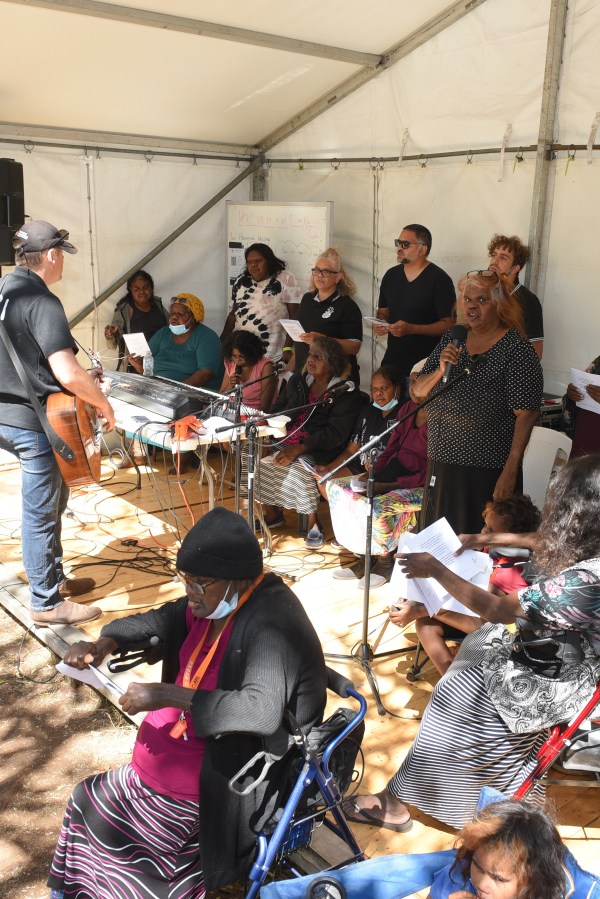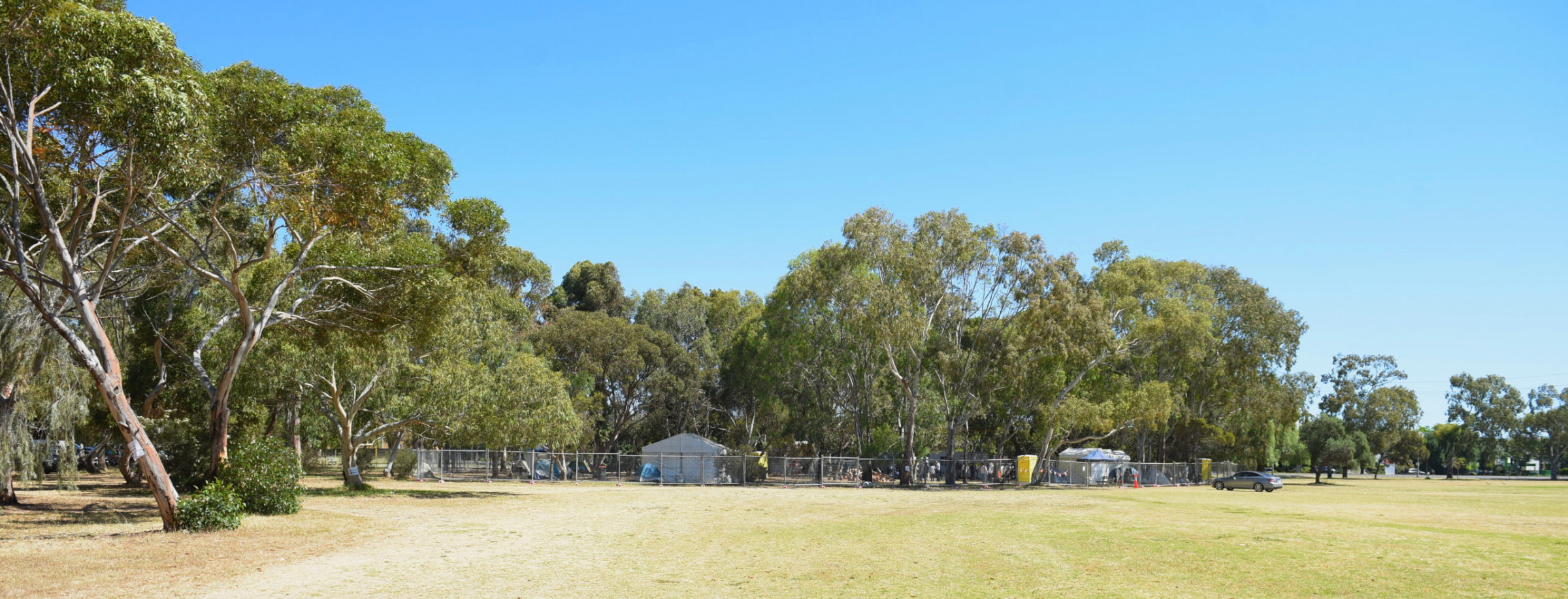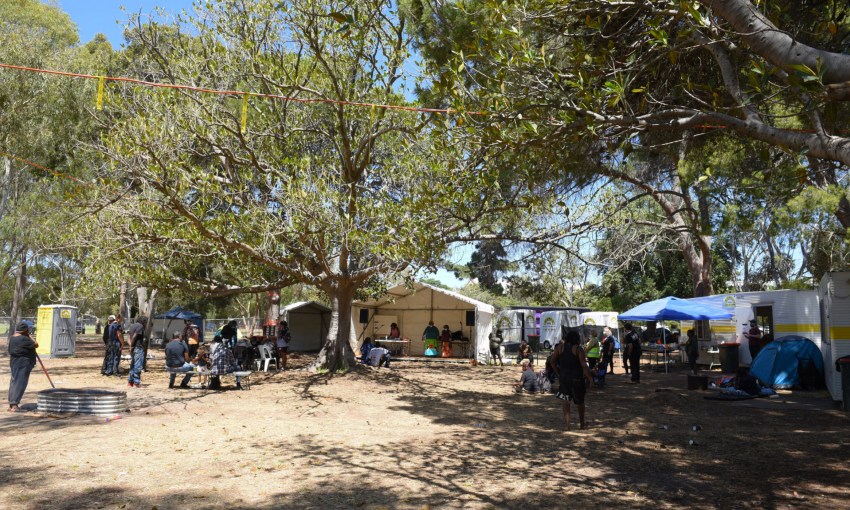As the Puti on Kaurna Yerta pilot program, designed to help Aboriginal remote visitors return to Country, comes to an end, CityMag spent a couple of hours getting to know the people the site has helped.
An afternoon at Puti on Kaurna Yerta
On a Thursday at the beginning of the month, cars and trucks rumble down Greenhill Road as CityMag wanders through the Adelaide Park Lands towards a chorus of singing voices.
The music is coming from behind a fence and a string of eucalyptus trees at the edge of Minno Wirra Park. Since October this year, this site has been known as Puti on Kaurna Yerta, or ‘Bush in the City’, set up to assist remote Aboriginal visitors return to Country.
Summer sunlight filters through the trees onto the dusty camp, as a small group of Aboriginal men and women sing in language from a makeshift stage. Some of Puti’s older clients sit in plastic chairs, mouthing along to the words.
The first person we meet is Aaron Ken, a Pitjantjatjara man and chairman of Iwiri, an Aṉangu Pitjantjatjara Yankunytjatjara organisation.
From within the camp’s engine room (a converted toilet block fitted out with desks, computers and a bag of kangaroo tails), Aaron hands CityMag the Iwiri Choir Songbook, which contains eight songs written in Pitjantjatjara. This is what the group is currently singing.
“Many Aṉangu grew up learning these songs,” text within the book says, “and older Iwiri members living in Adelaide for health reasons consider singing together and teaching to be a healing balm”.
The Puti program is in its pilot stage, which is due end on 17 December 2021. But Aaron, who is a Puti cultural leader, says the camp is just the start of a healing journey for the inhabitants and relationships between Aboriginal people and government services.
“I think it’s going to grow from here,” he says.
“This is where we need to make change, and I think people are seeing the benefit of this place.”
Aaron says this pilot has forced the public and government services not to continue to “ignore” Aboriginal rough sleepers and remote visitors in the Adelaide Park Lands anymore.
“When I say ‘ignore’, I don’t think people are aware of what was happening in the park lands and now they are,” he says.
“I don’t feel like people could turn back to the way it was before.”
PUTI’S GENESIS
InDaily revealed in October the South Australian Department for Human Services would immediately set up a temporary, multi-agency service hub for Aboriginal people sleeping rough. The goal was to help these people return to Country and access government support services, including Centrelink, NDIS and domestic violence services.
Lois Boswell told CityMag in October helping remote visitors is a “complex and long-running issue”, with the aim of Puti to improve the safety and wellbeing of at-risk visitors.
“Throughout this process, input from Aboriginal leadership has been critical and has allowed government and non-government services to understand the roadblocks affecting remote visitors and how best to assist them,” she said.
The solution – Puti – arrived nine months after a report found that without changes to the way Aboriginal people slept and gathered in the CBD, a “significant but unknown” number would continue to die in the city.
During that time, the Department for Human Services (DHS) and the cross-agency Safety and Wellbeing taskforce were busy attempting a bold new approach to helping remote visitors and Aboriginal rough sleepers.
CityMag reported in September that ad-hoc shelters in the city and Port Adelaide, which allowed alcohol consumption and emphasised First Nation input and translators, worked in helping this population stay safe from COVID-19.
Lois said this experiment successfully returned remote visitors home or helped get them into longer-term accommodation in Adelaide.
This initial Aboriginal-led pilot was deemed a success, and became a daring new direction for implementing and enacting government support.

The Iwiri Choir
A PICTURE OF PUTI
The fenced-off camp is nestled on the edge of Greenhill Road. Tents are banded together on the outer edges, with clusters dependent on language groups.
People from regional South Australia and the Northern Territory – spanning Warlpiri, Arrernte, Luritja, Pitjantjatjara and Yankunytjatjara mobs – are present today, Aaron says.
Campers are mostly made aware of Puti through word of mouth, direct referrals and outreach services going into the Adelaide Park Lands to speak to groups.
The camp is populated by roughly 70 clients, plus half a dozen plain-clothed government workers and around six SA Police officers. About five shower and toilet units are available, with demountable buildings staffed by government workers too. A huge stockpile of wood lays next to the choir stage, ready to be used in the many communal fire pits.
On the day we visit we meet again with Lois, who says the camp isn’t about solely assessing the inhabitants’ needs from a homelessness perspective. Many gather in the Adelaide Park Lands for different reasons, and Puti is designed to understand those motivations and fill in the gaps.
“Some are sleeping in the park lands. Some of the people who’ve been coming here have somewhere to stay in town but [it’s] with other people, so they’re kind of overcrowding houses, et cetera,” she says.
In our recent story examining who the Adelaide Park Lands are for, CityMag was told many Aboriginal leaders want a fixed place for First Nations people in the green belt, which already exists as a gathering place for the community.

Barry Rigney (pictured) heads-up Aboriginal Sobriety Group service Mobile Assistance Patrol, and previously told CityMag there is no designated area where Aboriginal people can sit down and gather as a community. This picture: Andre Castellucci
The wire fence encircling the dusty camp was erected after four weeks and was met with “a little bit” of resistance, Aaron says, but it was mostly welcomed and wanted by the people inside Puti.
“We’d have some people from outside the campsite, who weren’t our residents, who would come in and caused a bit of trouble,” Aaron says.
He tells us a story of a gentleman who slept rough in the Adelaide Park Lands who told him he wanted to feel secure at Puti.
“He had trouble sleeping because he constantly felt like he was worried about people coming to attack him. That’s the reality of what he was dealing with when he was out living rough in the park lands,” Aaron says.
A security team also monitors the camp, working from 7am ‘til 10pm, with visitors allowed during the day only.
While watching the Iwiri Choir, we meet a young woman in a blue hoodie who CityMag has not named due to privacy concerns.
She tells us she’s here to visit her in-laws, and after our introduction, we both watch a small scuffle break out in the middle of the camp. An older man, the initiator of the altercation, is escorted off Puti by police.
“Does this happen all the time?” our new friend asks us. Apparently, some fights have broken out in the camp, Lois explains, but that’s to be expected when tackling complex and long-running issues, such as addiction and multi-generational trauma.

Puti from a distance
Cultural leaders and task force representatives – from SA Police, Department for Human Services and SA Health – meet every morning in Puti’s engine room to discuss the prior 24 hours. A lot can happen in that time.
“There’s people talking about things that people might need, like ID or Centrelink or potential to return home,” Lois says, adding some people need assistance with court appearances or medical appointments.
TAFE SA’s mobile hairdressing and beauty salon, nicknamed Priscilla, has made an appearance at Puti, with one camper telling us she’d had her hair washed and massaged by a beautician.
Her eyes light up twice in our conversation, once when she described how DHS workers helped her get in contact with her kids, and again while showing us, with her hands running through her hair, how her scalp was touched.
These are anecdotes of the success of the Puti program, but measured results also tell a positive story.
RESULTS
Government data given to CityMag’s sister publication InDaily says that as of 6 December 2021, 75 Aboriginal people returned home through Puti. Almost half of these campers are from the Northern Territory.
Around 50 COVID-19 vaccinations have been administered, 45 identification cards have been processed and 21 Centrelink onsite appointments attended.
Uncle Jeffrey Newchurch, a Kaurna elder and chairperson of Kaurna Yerta Aboriginal Corporation, says Puti on Kaurna Yerta is an example of Aboriginal people providing Aboriginal solutions.
“By working together, we have the greatest opportunity of success,” he says.
The Assistant Commissioner of SA Police, Scott Duval, also says that since Puti’s inception, police have seen a reduction in anti-social behaviour in areas around North Terrace, Whitmore Square, and the west park lands.
Royal Adelaide Hospital’s emergency department co-director, Dr Christopher Hercus, says his department has also seen a decrease of presentations from remote Aboriginal visitors.
“The Hub’s assertive health and human services delivery, across multiple agencies and NGOs, seems to be resulting in less acute presentations and better outcomes for Aboriginal people,” he says.
Joining the chorus of supporters, Lord Mayor Sandy Verschoor lauds the success of this solution.
She says she will continue to work with the State Government to explore “all future options”.
From 17 December, when the Puti pilot is due to end, Lois says the DHS will continue to offer services.
“Outreach services and agency staff will continue to work with Aboriginal people who have accessed the Hub to support their individual programs and the outcomes they are seeking for themselves and their families,” a departmental document sent to CityMag says.

One of the clusters
Near the health demountable, a DHS worker named Fiona offers CityMag some damper with jam and butter. A female camper also gets her fill, with Fiona helping her wrap a few extra pieces in aluminium foil. Limited food is offered to clients, as they’re encouraged to go off-site and find their own.
Aaron says some individuals working within government departments don’t know how to engage with Aboriginal clients – or they may be scared of doing the wrong thing. This can result in giving “too much”.
The key is finding the sweet spot, and consulting with Aboriginal people on how to help Aboriginal people. This is ultimately what Puti is about – listening to culturally informed expertise.
“What happens is, it’s hard to pull that back because later we’ve just created this expectation,” Aaron says.
Instead, Aaron and other Aboriginal cultural leaders are helping government workers understand the Pitjantjatjara idea of ‘ngapartji ngapartji’, which is about reciprocity.
“Currently services try and build relationships that are either transactional in nature or they act like welfare and proceed to give them everything they ask for,” Aaron says. “Both are limited in creating change and are damaging in the long run by creating dependency.”
THE FUTURE
Lois says over the seven weeks, various agencies have learnt to “sit alongside, and not patronise”.
“Guidance from Kaurna and APY leaders was critical to government and non-government services understanding the roadblocks affecting remote visitors and how best to assist them,” she says.
Shaya Nettle, from multi-agency homelessness service provider Toward Home Alliance, believes that to continue building on the innovations and learnings of Puti, agencies must continue to work together on case planning, collaboration and outreach.
We notice a group of older females at the Puti camp sitting in a circle out the front of the health demountable. They’re taking selfies on an iPhone and singing.
Singing is a common practice at Puti – not just with the Iwiri choir, but also at ad-hoc moments like this.
Aaron says, for him, Puti feels like home.
“I grew up in community for a bit and even lived there in my older years. Times like today actually feels like the way it is up there,” he says.
And although the camp will be decommissioned in a couple of weeks, the relationships and learnings will remain. The government has now witnessed what happens when Iwiri and Kaurna lead solutions.
“They’ve seen how we work with our mob and our people’s people,” Aaron says, “and when things are led by Aboriginal people, I feel like people will be able to replicate it. But it has to be genuine.
“I’m not the only one who will say I think we will miss this place.”

This picture: Tony Lewis




